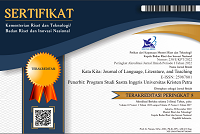Comparing and Contrasting the Samurai Gintoki and Hijikata Personalities from Gintama
DOI:
https://doi.org/10.9744/katakita.10.1.58-64Abstract
The mask or persona will be discussed in the first subchapter. Gintoki and Hijikata both have a mask that they wear to show to other people or society. Gintoki's persona is lazy, childish, and cowardly since his motivation is to live a carefree life, free of obligations, and to project an image that others will not hold high expectations of him. Behind every façade is their genuine personality, which they prefer not to project. The shadow will be discussed in the second subchapter. Their repressed feelings and flaws are contained in the shadow. I will also go through how each character's shadow works. Gintoki's shadow is his guilt about killing his own teacher as a result of being forced to make some difficult decisions. Whereas Hijikata’s shadow is regret of being unable to save his brother. The findings are that a human psyche is complex, and each has his different causes and outcomes.
Keywords: samurai, persona, shadow, anima, animus, personality
References
Jozuka, E. (2019, July 29). Japanese anime: from 'Disney of the East' to global industry worth
billions. CNN. Japanese anime: From 'Disney of the East' to a global industry worth
billions.
Henshal, K. (1999). Dimensions of Japanese Society (1st ed.). St. Martin’s Press, inc.
Macwilliams, M. W. (2008). Japanese Visual Culture. (1st ed.) Routledge. Japanese Visual Culture:
Explorations in the World of Manga and Anime - Mark W. MacWilliams - Google Books.
Roesch, S. (2009). The experiences of film location tourists. Bristol Channel View.
Downloads
Published
Issue
Section
License
Authors who publish with this journal agree to the following terms:- Authors retain copyright and grant the journal right of first publication with the work simultaneously licensed under a Creative Commons Attribution License that allows others to share the work with an acknowledgement of the work's authorship and initial publication in this journal.
- Authors are able to enter into separate, additional contractual arrangements for the non-exclusive distribution of the journal's published version of the work (e.g., post it to an institutional repository or publish it in a book), with an acknowledgement of its initial publication in this journal.
- Authors are permitted and encouraged to post their work online (e.g., in institutional repositories or on their website) prior to and during the submission process, as it can lead to productive exchanges, as well as earlier and greater citation of published work (See The Effect of Open Access).














